|
“An Underwater Treasure”
June 20, 2010, Beijing Review, China:
“Since April, Chinese archaeologists have salvaged more than 4,000 relics from Nan’ao 1, a merchant vessel lying on a 27-meter-deep seabed.
This is the only sunken ship China has discovered that dates back to the late Ming Dynasty (1368-1644). The salvage of Nan’ao 1 is listed as 2010’s ‘No.1 Project’ by China’s Underwater Cultural Heritage Protection Center.
The excavation of relics in the vessel is to be finished in the first half of 2010, and salvage of the wreck will be finished in the next two years.
China’s sea trade exporting silk and porcelain began to flourish in the 7th century, taking south China’s Guangzhou, Quanzhou, and Ningbo as its starting points.”
[Full Story]
“Call for full excavation of HMS Victory shipwreck”
June 15, 2010, BBC News, UK:
“An archaeologist has called for the wreck of the HMS Victory to be brought to the surface to avoid further damage.
Dr Sean Kingsley is an archaeological consultant for Odyssey Marine Exploration, who found the shipwreck in the English Channel in April 2008.
Two cannons brought up from the wreck confirmed its identity
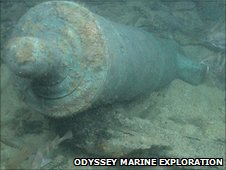
Odyssey Marine Exploration / BBC News
The site’s future is the subject of a public consultation ending on 30 June.
The consultation, being held by the UK government’s Department of Culture, Media and Sport and the Ministry of Defence, puts forward three options; manage the site with no excavation, limited excavation and management of the site and full excavation with the artefacts being used to educate and celebrate Britain’s heritage.”
[Full Story]
“New relics found on ancient sunk ship”
June 14, 2010, XinhuaNet, China:
“A batch of new relics from the ancient sunken ship Nan’ao 1 is open to the media. They are among the nearly five thousand antiques found underwater.
Not only broken pieces are on display but well-preserved ones are also being shown.”
[Full Story]
“Underwater Ruins Give Glimpse of Cleopatra”
June 10, 2010, ABC News, USA:
“Deep beneath the Mediterranean Sea in Egypt’s ancient capital Alexandria lies a wealth of archaeological artifacts.
It’s a treasure trove of 20,000 objects and counting, thousands of years old providing archaeologists the key to unlocking the mystery of ancient Egypt and its rulers.
A French team lead by Frank Goddio has been leading the excavation along with an Egyptian counterpart since 1992 when the dig first started.
Egyptologist and underwater archaeologist Ashraf Abdel Raouf is also part of this project and he explained to ABC News that they found ‘ceramics, bronze coins, small objects that are now in a laboratory and under restoration … remarkable objects’, adding that because ‘it was in the sea, it’s been conserved as it was sunken. We found pottery, statues as well and the sea conserved them.’
Underwater archaeologists have already started looking into and researching an underwater museum.”
[Full Story]
“Corolla shipwreck may be North Carolina’s oldest”
June 06, 2010, News Observer, USA:
“A shipwreck exposed on the beach by winter storms could date to a time of commerce between England and Jamestown in the early 1600s.
Possibly the oldest known wreck on the North Carolina coast, the timbers and construction of the ship are very similar to the Sea Venture, the 1609 flagship of seven vessels that carried people and supplies to Jamestown, said Bradley A. Rodgers, a professor of archaeology and conservation in the maritime studies program at East Carolina University.
Volunteers and members of the N.C. Wildlife Resources Commission work April 6 to remove what remains of a shipwreck on the beach in Corolla.
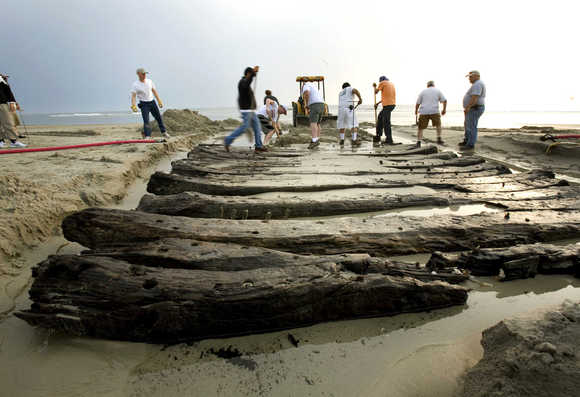
L. Todd Spencer – The Virginian-Pilot
Remains of the Sea Venture rest off the Bermuda coast after it ran aground there in 1609 during a storm.
The wreck at Corolla grabbed attention after it was exposed following November nor’easters.
On April 6, crews from the state Wildlife Resources Commission, the Corolla fire department and residents hoisted it from the sand and dragged it on a sled to a lot near the Currituck Beach Lighthouse.”
[Full Story]
“Divers explore sunken ruins of Cleopatra’s palace”
May 25, 2010, The Seattle Times / AP, USA:
“Plunging into the waters off Alexandria Tuesday, divers explored the submerged ruins of a palace and temple complex from which Cleopatra ruled, swimming over heaps of limestone blocks hammered into the sea by earthquakes and tsunamis more than 1,600 years ago.
The international team is painstakingly excavating one of the richest underwater archaeological sites in the world and retrieving stunning artifacts from the last dynasty to rule over ancient Egypt before the Roman Empire annexed it in 30 B.C.
Using advanced technology, the team is surveying ancient Alexandria’s Royal Quarters, encased deep below the harbor sediment, and confirming the accuracy of descriptions of the city left by Greek geographers and historians more than 2,000 years ago.
Since the early 1990s, the topographical surveys have allowed the team, led by French underwater archaeologist Franck Goddio, to conquer the harbor’s extremely poor visibility and excavate below the seabed.
They are discovering everything from coins and everyday objects to colossal granite statues of Egypt’s rulers and sunken temples dedicated to their gods.”
[Full Story]
“SS Maui wreckage a UH laboratory”
May 24, 2010, Honolulu Advertiser, Hawai’i:
“The SS Maui, a little-known shipwreck off the coast of the Big Island, is about to be turned into an underwater laboratory for oceanography students and teachers.
University of Hawai’i students and professionals will spend three weeks starting next month doing field work surveying the SS Maui, an interisland steamer that struck a reef in 1917 at Makalowaena off Kona Coast State Park.
University of Hawai’i students and teachers will spend about three weeks surveying the wreckage of the SS Maui.
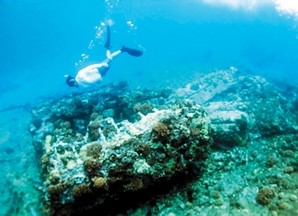
NOAA / Honolulu Advertiser
Six students from UH’s Marine Options Program on O’ahu and Hilo will survey the site with digital cameras, diagrams and measurements.
The underwater classroom is made possible by the National Oceanic Atmospheric Administration Office of National Marine Sanctuaries Maritime Heritage Program, which preserves historical, cultural and archaeological resources in the sanctuaries and the UH Marine Option Program.”
[Full Story]
“Concerns Over 10th Century Wreck”
May 10, 2010, Hydro International, Netherlands:
“The Director-General of UNESCO, Irina Bokova, expressed concern about negotiations to sell a large number of artefacts salvaged from the wreck of a 10th century ship lying off the coast of Java (Indonesia).
The sale of the cargo by the Indonesian government was originally set for 5th May in Jakarta but it was postponed for lack of a buyer.
‘It would be unfortunate to allow heritage of such historical and archaeological value to be scattered, thereby depriving both scientists and the general public of access to an exceptional collection. Exploiting an archaeological site and dispersing its artefacts is an irreversible process.’
‘Yet the contents of the shipwreck found off the coast of the city of Cirebon have much to tell us about cultural and commercial exchanges in the region at that time’, said Ms Bokova.
‘UNESCO, through its 2001 Convention on the Protection of the Underwater Cultural Heritage, urges States to safeguard sunken heritage and to make it available for scientific study and public enjoyment.’
‘We therefore encourage the Indonesian government to make every effort to ensure that thorough scientific examination of the site is carried out and the artefacts are presented in museums.’“
[Full Story]
“Large number of cultural relics from ‘Nan’ao No. 1’
will be out of water”
May 10, 2010, People’s Daily, China:
“The progress of excavation of the ‘Nan’ao No. 1’ ancient ship is entering its inside, and the discovery and research of the ship will fill the blank of research of trade and commerce ship in late Ming dynasty.
Sun Jian, from National Underwater Heritage Protection Center and also the archaeological team leader for the ship, told reporters that from yesterday on, the excavation of the ship is mainly inside of it and large number of cultural relics will be out of water if weather permits; although thousands of cultural relics had been excavated out water before, most of them were found at the surface of the ship and in the mud.
Parts of cultural relics of “Nan’ao No.1” ancient shipwreck
had been salvaged from water recently
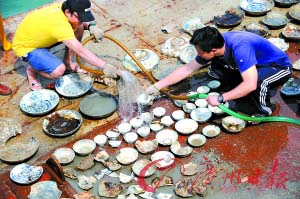
People’s Daily, China
Since cultural relics from ‘Nan’ao No. 1’ were firstly exhibited before media on May 1st, materials kept being out of water from the ship in the next week.
Now, the excavation to the ship’s surface is almost finished and work of clearing mud is ending, too.
Next, archeologists are going to excavate the ship from its right shipboard to the inside of cabin.
Sun also said they would carefully maintain the balance of pressure that both sides of the ship burden, thus when those cultural relics were took out of it, the ship would not be collapsed because of sudden empty and change of pressure.”
[Full Story]
“Work begins to preserve QAR artifacts on ocean’s floor”
May 09, 2010, JD News, USA:
“The latest efforts to preserve artifacts from the shipwreck presumed to be Queen Anne’s Revenge never left the sea floor.
Staff from the N.C. Underwater Archaeology Branch conducted a three-day expedition at the QAR site this week and focused on a new ‘in situ’ method of conservation that begins the process while artifacts are still on the ocean’s bottom.
Skinny aluminum rods called sacrificial anodes were attached to several anchors and a cannon to change the electrochemical process that corrodes iron in saltwater, reducing or even reversing the amount of salts absorbed by the iron objects, said QAR Project Director Mark Wilde Ramsing.”
[Full Story]
“University divers plumb new depths in Egypt”
May 05, 2010, BBC News, UK:
“University of Ulster divers have been passing on their expertise to maritime archaeologists in the historic Egyptian port of Alexandria.
Staff from the UU’s maritime archaeology centre conducted a 10-day training workshop for 15 archaeologists from north and east Africa who wanted an insight into the challenges of working underwater.
One of the UU divers who were granted rare access to
the ruins of the great lighthouse of Pharos
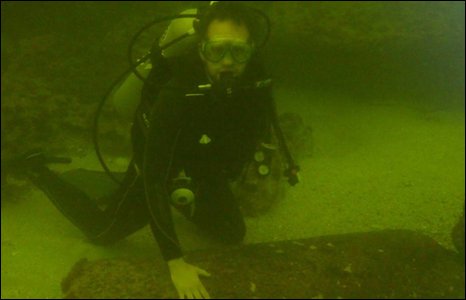
University of Ulster / BBC News, UK
During their stay the UU divers were granted a rare opportunity to explore the underwater remains of the famous Pharos lighthouse – one of the wonders of the ancient world.
Work on the great lighthouse began in 290 BC and when it was completed 20 years later, it was the first lighthouse in the world and the tallest building in existence with the exception of the Great Pyramid.”
[Full Story]
“Treasure hunter Michael Hatcher
becomes prey for ‘deep-sea looting’”
May 01, 2010, The Times, UK:
“A veteran British treasure hunter faces jail for allegedly plundering artefacts from subterranean wrecks in tropical waters off Indonesia.
Indonesian authorities are pursuing Michael Hatcher, a British-born resident of Australia who has made millions from recovering treasures from ancient vessels.
Michael Hatcher with a vase from the Tek Sing
a Chinese shipwreck from 1822
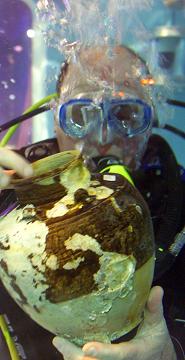
The Times, UK
He denied any wrongdoing and said that the investigation was politically motivated.
Police said yesterday that maritime police were tracking Mr Hatcher on suspicion of illegally removing Chinese Ming porcelain from a wreck off Blanakan, on the north coast of the central Indonesian island of Java.”
[Full Story]
“Scuba diving volunteers discover underwater archeology”
April 29, 2010, VC Reporter, USA:
“Coastal Maritime Archeology Resources members spend about a week living aboard research vessels stwice a year, to measure and map shipwrecks, sunken airplanes and archeological sites scattered on the ocean floor.
A dedicated group of volunteer scuba divers employ their expertise surveying
underwater archeology in the Channel Islands Marine Sanctuary
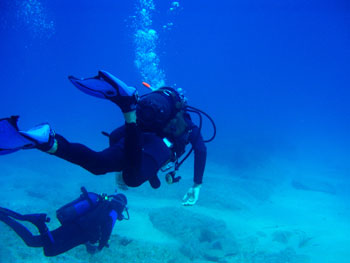
VC Reporter, USA
CMAR Director of Operations Patrick Smith says there’s nothing quite like seeing a shipwreck for the first time.
‘It’s indescribable. There’s excitement, maybe a little bit of trepidation’, says Smith. There’s that wonderful feeling of breaching the unknown. There’s the anticipation of seeing something that nobody has seen for scores of years, or maybe hundreds of years.’“
[Full Story]
“Hundreds of rare Roman pots discovered by accident
off Italy’s coast by British research ship”
April 13, 2010, Daily Mail, UK:
“A British underwater research team has discovered hundreds of rare Roman pots by accident, while trawling the wreckages of ships on the sea bed.
The team had been using remote operated vehicles (ROVs) to scour modern wrecks for radioactive materials.
An underwater research team brought up five pots from the seabed
but said there were hundreds still down there
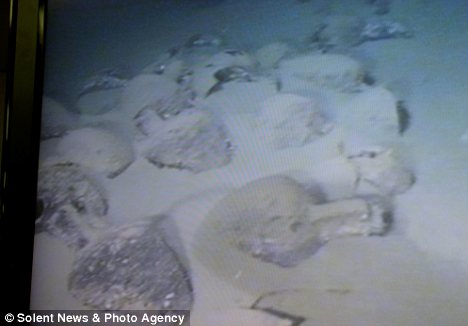
Solent News & Photo Agency / Daily Mail
They were amazed to come across the remains of a Roman galley which sank off the coast of Italy thousands of years ago.
The crew from energy company Hallin Marine International, based in Aberdeen, found a number of ancient pots lying in the mud 1,640ft below the waves.”
[Full Story]
“Plan in works to salvage remnants of N.C. shipwreck”
April 01, 2010, The Virginian-Pilot, USA:
“State engineers and volunteers plan to salvage what could be the oldest shipwreck remains known on the North Carolina Outer Banks.
Remains of a shipwreck on the beach in Corolla, N.C. on Tuesday, March 16, 2010. The wreck shown here could be the oldest ship wreck on the Carolina coast.
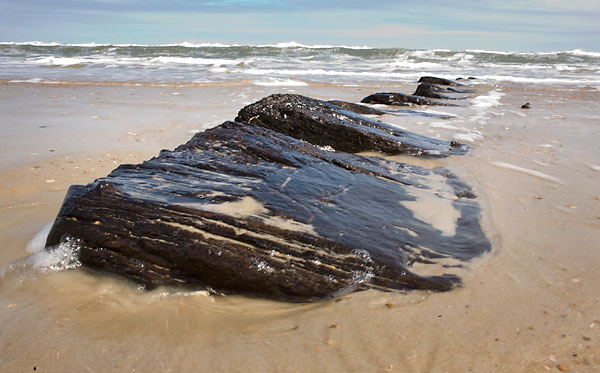
The Virginian-Pilot, USA
Plans are to move the wreck next week from its precarious place in the sand and surf to a plot near the Currituck Beach Lighthouse in Corolla, keeper Meghan Agresto said.
Some are concerned the ship would go to pieces and disappear if left alone.”
[Full Story & More Images – prints are for sale]
“Kenyan divers join search for Chinese wreck”
March 26, 2010, IOL, South Africa:
“Kenyan and Chinese divers will embark on an undersea mission to find the wreckage of a Chinese vessel that sank off the East African country’s coast 600 years ago, an official said on Thursday.
The ship is believed to have been part of a trading expedition that arrived in east African coastal waters in 1418 under admiral Zheng He’s command.
China is financing the search, which is to begin this year, for the boat off Pate island in the southeast of Kenya. The three-year search will cost around two million euros.
‘For me the ship is there. The general situation is known, off the village of Shanga’, said Idle Farah, the director of National Museums of Kenya.”
[Full Story]
“Mary Rose’s canine catcher revealed”
March 16, 2010, DiverNet, UK:
“The 16th century remains were revealed, somewhat appropriately, by courtesy of the Kennel Club at the DFS Crufts show, held at Birmingham’s NEC from 11-14 March.
The skeleton of a ship’s dog excavated from the Solent’s Mary Rose
wreck site has been displayed for the first time
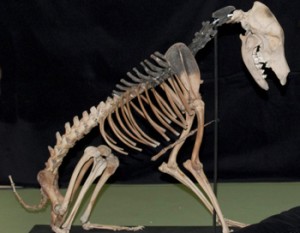
DiverNet, UK
Next, they will go on display at the Mary Rose Museum in Portsmouth Historic Dockyard, from 26 March.
The dog, identified as a two-year-old female mongrel, would have been kept aboard to catch rats and other vermin. Cats were not used, as seamen regarded their presence as unlucky.
The dog was named Hatch by her excavators, after being found near the sliding hatch door of the carpenter’s cabin.”
[Full Story]
“Gas pipeline probe uncovers shipwrecks in Baltic Sea”
March 08, 2010, Yahoo News / AFP, France:
“A dozen previously unknown shipwrecks, some of them believed to be up to 1,000 years old, were discovered in the Baltic Sea during a probe of the sea bed to prepare for the installation of a large gas pipeline, the Swedish National Heritage Board said Monday.
Map of northern Europe showing the route of the
planned Nord Stream gas pipeline

Patrice Dere for AFP
‘We have managed to identify 12 shipwrecks, and nine of them are considered to be fairly old’, Peter Norman, a senior advisor with the heritage board, told AFP.
‘”We think many of the ships are from the 17th and 18th centuries and we think some could even be from the Middle Ages’, he said, stressing that ‘this discovery offers enormous culture-historical value.’
The shipwrecks were discovered during a probe by the Russian-led Nord Stream consortium of the sea bed route its planned gas pipeline from Russia to the European Union will take through the Baltic.”
[Full Story]
“China, Kenya to search for ancient Chinese wrecks”
February 26, 2010, WEAR ABC 3 News / AP, USA:
“An agreement has been signed to allow a search for part of China’s distant past off the coast of East Africa.
A three-year project will allow exploration of waters near the popular Kenyan tourist towns of Malindi and Lamu in an attempt to find ancient Chinese ships wrecked almost 600 years ago.
The official Xinhua News Agency reports exploration work will be conducted for up to three months each year, possibly starting as early as July.”
[Full Story]
“Bronze Age shipwreck found off Devon coast”
February 14, 2010, The Sunday Telegraph, UK:
“One of the world’s oldest shipwrecks has been discovered off the coast of Devon after lying on the seabed for almost 3,000 years.
The trading vessel was carrying an extremely valuable cargo of tin and hundreds of copper ingots from the Continent when it sank.
In total 295 artefacts have so far been recovered
weighing a total of more than 84kg
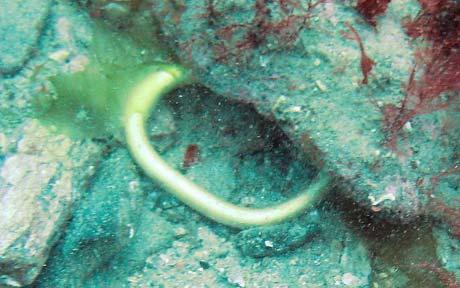
The Sunday Telegraph, UK
Experts say the ‘incredibly exciting’ discovery provides new evidence about the extent and sophistication of Britain’s links with Europe in the Bronze Age as well as the remarkable seafaring abilities of the people during the period.
Archaeologists have described the vessel, which is thought to date back to around 900BC, as being a ‘bulk carrier’ of its age.
The copper and tin would have been used for making bronze – the primary product of the period which was used in the manufacture of not only weapons, but also tools, jewellery, ornaments and other items”
[Full Story]
“New Underwater Archaeological Site Designated
Off Polyaigos Island”
February 01, 2010, Balkan Travellers, Bulgaria:
“A shipwreck located off the small uninhabited Cycladic island of Polyaigos in the central Aegean will be designated as an “underwater archaeological site” by Greece’s Culture Ministry, the institution’s representatives announced recently.
The shipwreck, first spotted in 2004, was initially explored by underwater archaeologists in the fall of 2009, the Athens News Agency reported today.
An image of the sunken shipwreck off Polyaigos Island
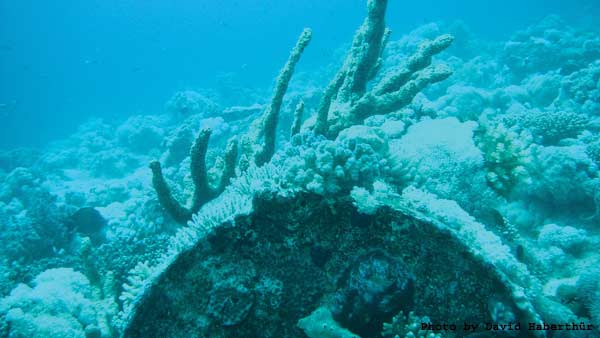
Balkan Travellers, Bulgaria
These excavations resulted in the discovery of valuable archaeological objects, including amphorae, ceramic vases and fragments of the vessel’s anchor.
In addition, the shipwreck was photographed and filmed in detail, which allowed the creation of a high-definition photo-mosaic, while procedures have been set in motion to designate the area as an underwater archaeological site.”
[Full Story]
“Hidden Wrecks Revealed”
January 29, 2010, Northumberland Gazette, England:
“Nearly a thousand new archeological sites have been discovered off the North East coast as part of an English Heritage-funded project.
During the survey, conducted by EH archaeologists along with help from Northumberland Coast Area of Outstanding Natural Beauty, ship wrecks, wartime defences and medieval remains have been uncovered.
Four shipwrecks revealed on the mud flats at Amble
during a survey by English Heritage archaeologists
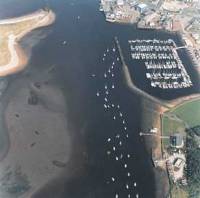
Northumberland Gazette
The survey has been done to help researchers understand the history of the coastline and damages it may face.
Among the results were four ship wrecks found in mud flats off the coast of Amble. Their existence had previously been recorded, but until the survey took place their exact location was not known.”
[Full Story]
“Exploration of shipwreck of Polyaigos”
January 29, 2010, Athens News Agency, Greece:
“The Culture Ministry intends to designate a shipwreck off the tiny uninhabited Cycladic isle of Polyaigos, in the central Aegean, as a ‘underwater archaeological site’ after completion of an initial examination of finds that surfaced during recent marine digs, according to a ministry announcement.
Divers on the maritime excavations in November 2009 recovered vases dating back to the 4th and 5th centuries BC from depths of 25-49 meters off the coast of Polyaigos.
Aquatic archaeologists brought up such artifacts as amphorae used for carrying, and small table ceramic vases, all intact, as well as fragments of the shipwrecked vessel’s anchor.
The ancient vessel was loaded with amphorae, which are scattered around the wreck in two main concentrations.”
[Full Story]
“Galle: A treasure trove of wrecked ships”
January 17, 2010, The Sunday Times, Sri Lanka:
“Galle port with its splendid natural harbour was an important port in days of yore being reputed as a trade centre due to its location just 12 miles away from international sea routes.
Many sunken ships have been found here according to the UNESCO Pacific Zone’s marine archaeological centre in Galle Fort.
An ancient clay pot retrieved from the seas
off Godawaya in Ambalantota
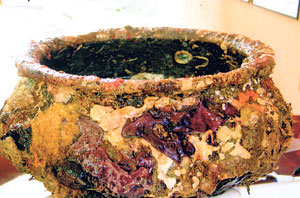
The Sunday Times, Sri Lanka
There are as many as 26 places that need to be surveyed here which have a history dating back a hundred years.
Along the coast in the Galle and Ambalangoda areas more than 100 wrecks of ships are reported have been found already.”
[Full Story]
“Treasure found off La Manga”
January 15, 2010, Le@der, Spain:
“Buried beneath shells, rocks and sand, for 2,600 years, while the construction boom has been completely changing the surrounding landscape, a treasure of incalculable value has lain just off La Manga.
Now, 26 centuries later, archaeologists from eleven countries are bringing these antique objects to the light of day once again.
divers retrieving some of the artifacts found
off the coast of La Manga
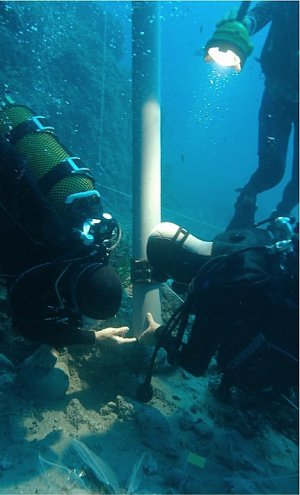
The Le@der
The find appears to be the cargo of a commercial ship carrying ivory from African elephants, amber and lots of ceramic objects.
The find has been kept secret for the past three years by the team of divers led by the Spaniard Juan Pinedo Reyes and the American Mark Edward Polzer.
The recovery project is being financed by National Geographic, who have reached an agreement with the Spanish Minister of Culture, the Institute of Nautical Archaeology and the University A&M of Texas.”
[Full Story]
“Shipworm migration poses risk for Swedish sea treasures”
January 14, 2010, The Local, Sweden:
“A number of maritime treasures off Sweden’s southern coast are under threat from the shipworm, which is gaining a foothold in the Baltic Sea due to climate change, according to researchers at the University of Gothenburg.
‘We’re quite worried about wrecks off the coast in southwest Sweden, outside of Skåne’, University of Gothenburg marine biology researcher Christin Appelqvist told The Local.
According to Appelqvist and her colleagues, around 100,000 well-preserved ship wrecks are scattered across the bottom of the Baltic Sea.
Traditionally, shipworms have avoided the Baltic Sea due to its lower salt content.
The Baltic therefore holds a number of archeological finds featuring wrecks of wooden ships and structures which would not likely have survived were it not for the mild salinity levels of Baltic waters.
But the Teredo navalis species of shipworm, one of 65 varieties found throughout the world, has been making its way into the Baltic Sea, having been spotted along both the Danish and German coasts in the southern Baltic.”
[Full Story]
“Is this a wall of Dwarka?”
January 04, 2010, Mid Day, India:
“14-km long wall discovered near the Konkan coast could lead to a fort, say archaeologists.
The text in question was written in cuneiform on a 3,700-year-old tablet brought to England from the Middle East more than sixty years ago by an RAF soldier, Leonard Simmons.
If James Cameron, director of the Hollywood block buster Avatar, had known what a noted Pune archeologist has discovered in the waters of the Arabian Sea, he would probably be tempted to make a sequel to his film. But unlike Avatar, a film that depicts the way humanoids exist in the future, this discovery could throw light on the ancient civilization that existed hundreds of years ago.
Archaeologist Ashok Marathe and his team accidentally discovered a massive underwater 14-km wall under the sea near Valneshwar off the Ratnagiri coast.
And the discovery has baffled archaeologists and oceanologists, who are trying to figure out which ancient civilisation could have constructed such a big wall and that too under the sea.
The purpose of constructing an underwater wall is equally baffling.”
[Full Story]
“Noah’s Ark not what we thought”
January 02, 2010, The Examiner, USA:
“According to a recently translated ancient Babylonian text, Noah’s famous vessel depicted in the Christian imagination as a double-prowed wooden ship, was actually a circular raft, made of reeds.
The text in question was written in cuneiform on a 3,700-year-old tablet brought to England from the Middle East more than sixty years ago by an RAF soldier, Leonard Simmons.
A traditional depiction of Noah’s Ark

Wikimedia Creative Commons
Douglas, son of Leonard, recently brought the tablet to Dr. Irving Finkel Assistant Keeper of Department of Middle East at the British Museum, who read the 60 lines of text and ‘nearly fell off his chair’.
According to Finkel, dozens of such tablets have told the ancient Mesopotamian story of the flood, which was later adopted as the account of Genesis, in the Old Testament.
But this is the first to describe the actual shape of the boat itself.”
[Full Story]
|